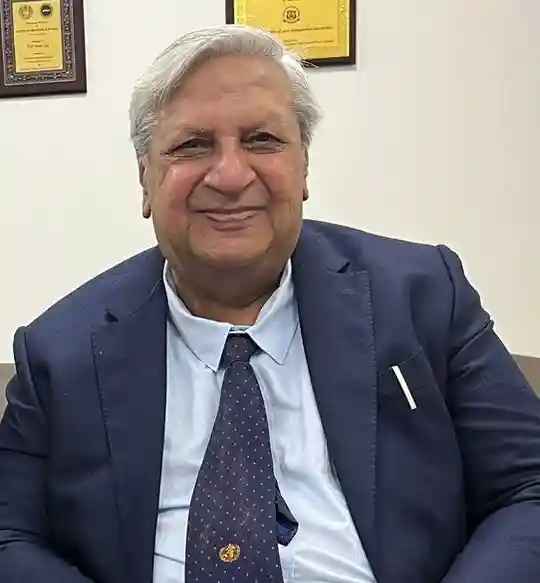Paralysis Attack: Symptoms, Causes, & Treatment

Medically Reviewed By
Prof. Ashok Rattan
Written By Muskan Taneja
on Sep 27, 2024
Last Edit Made By Muskan Taneja
on Jul 19, 2025

The nervous system serves as a conduit for the brain to transmit messages to various body parts. Paralysis occurs when muscle function is lost in part of your body. It can be permanent or temporary and occurs on one or both sides of your body. Paralysis attack in the arms or legs is quadriplegia, while paralysis in the lower half (including both legs) is paraplegia. A study found that over 490,000 people in India developed oral polio vaccine (OPV) between 2000 and 2017. Let’s understand everything from symptoms to causes and treatments for paralysis attacks.
What is a Paralysis Attack?
A paralysis attack is a sudden loss of movement in voluntary muscles in one or more body parts. It can cause nervous and brain dysfunction and may temporarily or permanently affect any body part.
Muscle atrophy, pain, involuntary cramps, muscle weakness, and numbness are some signs of a paralysis attack. Some people may experience temporary or permanent signs of a paralysis attack. Permanent means that the condition can’t be reversible, while in a temporary attack, it can be.
Types of Paralysis Attack
Your doctor may diagnose a paralysis attack based on muscle weakness and nerve damage.
There are five types of paralysis attacks based on muscle weakness. These are diplegia, hemiplegia, monoplegia, paraplegia, and quadriplegia.
Two types of paralysis attack based on nerve damage and its recovery potential. These are complete paralysis and incomplete paralysis.
Your healthcare provider may diagnose a paralysis attack based on muscle weakness:
- Diplegia- When your identical body part suffers paralysis, for example, both arms or legs.
- Hemiplegia- When paralysis attacks on either side of your body, such as paralysis attack on the left side of the body.
- Monoplegia- When one limb of either leg or arm experiences paralysis.
- Paraplegia- When both legs and trunk(in some cases) lose motor or nerve functioning.
- Quadriplegia- When all four limbs are immobilized because of certain damage in the spinal cord. In some cases, paralysis may affect the chest and trunk.
May diagnose a paralysis attack based on nerve damage and its potential recovery situation:
- Complete Paralysis: When there are no or fewer chances of recovery, muscles shrink and become flaccid, and you lose total control of voluntary movements and sensations below the injury levels.
- Incomplete Paralysis: When there are chances of recovery and your neural connection remains intact, which allows partial movements and sensations.
Also, read https://redcliffelabs.com/myhealth/lab-test/5-preventive-tests-youth-shall-start-in-their-20s/
What is the Situation of Paralysis in India?
- Indian Institute of Paralysis shares that 12,000 to 15,000 people out of every one crore have paralysis.
- Another study found that 490,000 Indians developed paralysis because of the oral polio vaccine, especially between the years 2000 and 2017.
- A study specifically in people between the ages of 30 and 50 is most likely to increase paralysis and stroke rates by almost 50% each year.
The situation is quite alarming. But what can cause paralysis? Let’s find out.
What Are The Causes of Paralysis Attack?
Paralysis is directly related to the nervous system. The brain transfers signals to the nervous system, which then gives commands to the body. Any dysfunction or damage in the nervous system can’t get through muscles.
Congenital disabilities, such as spina bifida, may cause paralysis attacks. However, other causes of paralysis attacks include:
- Traumatic injury
- Certain medical condition
- Strokes
- Spinal cord injuries
- Autoimmune diseases such as Guillanin-Barre syndrome and multiple sclerosis
- Brain injuries
- Neurological diseases
What Are The Symptoms of a Paralysis Attack?
Paralysis attacks directly the nervous system, which may affect any part of the body. It can cause a spinal cord injury and stroke that may cause sudden paralysis. Some symptoms of a paralysis attack include:
- Muscle cramps
- Numbness or tingling in the limbs
- Steady loss of feeling and muscle control
How To Diagnose Paralysis Attack?
Your doctor may inquire about you and your injuries to understand the situation. They may order some tests to diagnose paralysis attacks. These include:
- Electromyogram (EMG)- With this test, they may detect the electrical activity of your nerves and muscles.
- Myelogram- This test helps detect spinal cord and nerve injuries.
- X-rays help monitor broken bones and locate the reason for nerve injury.
- Imaging Tests- Tests, like CT scans or MRIs, may help detect signs of stroke, spinal cord injury, and brain injury. These tests provide complete body screening, showing bones, muscles, and tissues.
What Are The Complications of Paralysis Attack?
Paralysis attack is a condition that may affect other body parts as well. After locating the type of paralysis, you may be at risk for:
- Breathing issue
- Heart rate
- Difficulty in breathing and coughing
- Risks of pneumonia
- Dysphagia, i.e., speech or swallowing problems
- Deep Vein Thrombosis and blood clots
- Depression
- Stress and anxiety
- Erectile dysfunction
- Sexual problems
- Autonomic dysreflexia (high blood pressure)
- Orthostatic hypotension (low blood pressure)
- Heart problem
- Urinary incontinence
- Irregular bowel movements
- Bedsores (injuries)
- Sepsis
Also, read https://redcliffelabs.com/myhealth/lab-test/blood-tests-for-heart-diagnosing-heart-conditions/
How To Prevent The Paralysis Attack?
Congenital disabilities are one major reason for paralysis attacks, which may create difficulty in preventing risks of paralysis attacks. However, certain medical conditions, health issues, and injuries may lead to paralysis. Ways you can avoid a paralysis attack.
- Have a well-balanced and nutrition-rich diet.
- Exercise at least 30-45 minutes daily to improve your overall health.
- Avoid smoking, and if you are an active smoker, practice to limit or quit smoking.
- Keep track of your BMI by maintaining your weight as per your height, age, and gender.
- Indulge in regular health check-ups, making detecting early signs of an underlying disease easy.
It is better to take preventive measures before the situation worsens. Redcliffe Labs is a pan-India diagnostic lab that aims to provide quality diagnostic services to every Indian. They offer over 3,600 tests with a home sample collection service. Their smart full-body checkup provides a holistic health evaluation and detection of potential health issues.
What is The Treatment for Paralysis Attack?
There is no permanent paralysis attack treatment. Temporary paralysis goes away in some time without treatment. However, physical, occupational, and speech therapy can improve functioning. Your healthcare provider may detect the cause and type of paralysis attack and align treatment. It includes:
- Rehabilitation: Your doctor may perform physical, speech, and occupational therapy to help regain lost functions. The treatment includes adaptive and assistive equipment, voice-activated technology, and orthotic or prosthetic devices.
- Surgery: They may include decompression surgery to stabilize the spine and relieve pressure. In situations like hemorrhagic strokes, surgery can repair damaged blood vessels and relieve pressure on the brain.
- Medication: They may prescribe certain medications, such as muscle relaxants, pain relievers, or certain medical drugs, to treat infection and inflammation. These medications may help restore blood flow and dissolve blood clots.
Key Takeaways
Paralysis can affect temporarily or permanently. It is a life-changing and severe condition that may occur suddenly. With the right treatment and diagnosis, you can overcome it. Early detection of signs and preventive measures can help relieve paralysis attacks. Physical and medical therapy can help people recover from the disease.
Regular testing may help prevent the risk of paralysis attacks. Visit the Redcliffe Labs website and book a full-body health checkup today!



